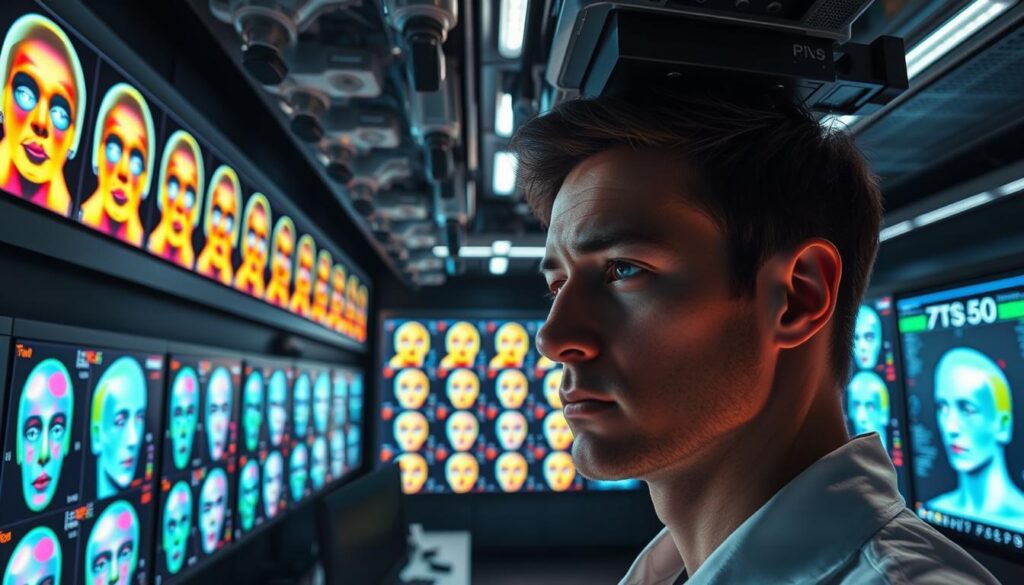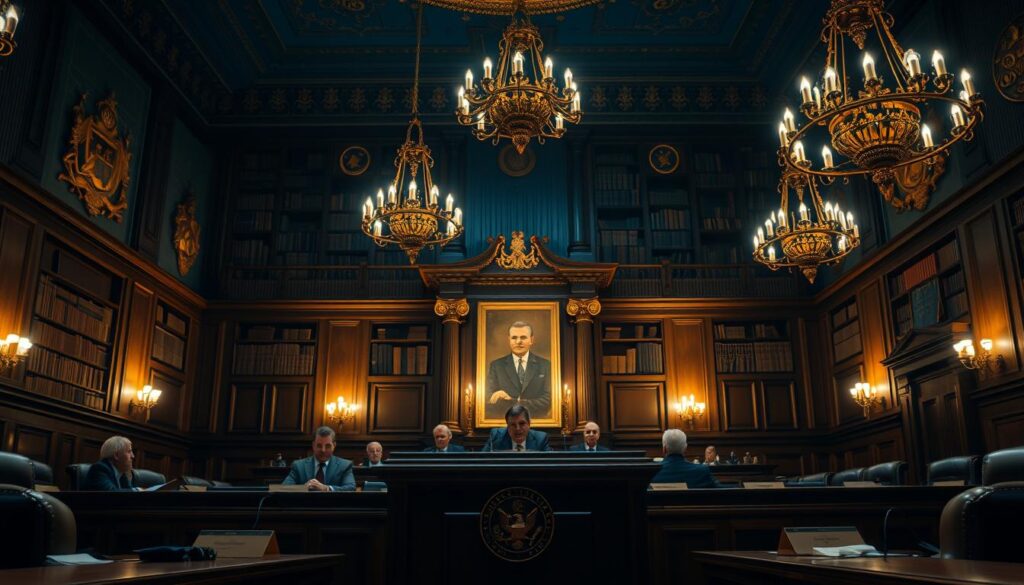Is facial recognition technology becoming a big issue in US security? It's used in many places, like law enforcement and stores. This raises big questions about privacy and fairness.
This part talks about how facial recognition is changing security tech. We'll look at who's involved and why people care so much. The mix of safety and privacy is a big puzzle we'll dive into.
Key Takeaways
- Facial recognition technology is increasingly integrated into security measures across various industries.
- The public's interest in facial recognition security is growing amid concerns about privacy.
- Advancements in facial recognition have led to increased effectiveness in many applications.
- Market players in facial recognition technology are expanding, driving innovation and competition.
- The balance between enhancing security and maintaining privacy presents significant challenges.
Introduction to Facial Recognition Technology
Facial recognition technology is a big step forward in identifying people. It uses smart algorithms to look at a person's face. This helps find and check who someone is.
First, the software finds a face in an image. Then, it makes a detailed map of the face. This map shows the face's unique features.
Next, the map is compared to faces in a database. This makes it very good at finding matches. Thanks to AI, these systems have gotten much better over time.
Companies like Clearview AI, NEC, and Cognitec are leading the way. They make facial recognition technology better. They use it in many areas, like security and shopping. Knowing how it works helps us understand its big role in our world.
Current Landscape of Facial Recognition in the US
Facial recognition technology is now used in many places in the United States. Governments use it for watching over areas and catching criminals. Companies use it to let people in and to know who their customers are.
Healthcare places are also using it to make things easier and safer for patients.
More and more places are starting to use facial recognition. Over 60% of police departments now have this technology. This shows how important it is becoming for keeping people safe.
People have different thoughts about facial recognition. Some worry about privacy and how it's used. But others think it's a good way to keep everyone safe.
As we talk more about facial recognition, we need to watch how everyone reacts. We should think about how it affects our rights and safety. This will help us make good rules for using this technology.
Applications of Facial Recognition in Security
Facial recognition helps make places safer in many ways. It's used in access control systems to let the right people in. Airports and big events use it to keep everyone safe by quickly spotting any dangers.
Smartphones use facial recognition to unlock and check who's using them. This makes it harder for bad guys to get into your stuff. It keeps your private info safe and cuts down on scams.
Facial recognition also helps solve crimes. Police use it to look at videos and find bad guys. Places that use it have seen better crime solving, making everyone safer.
Using facial recognition in security has many good points. It makes places safer and more efficient. It's a big help in keeping us all safe.
Advancements in Facial Recognition Accuracy
New tech makes facial recognition much better. It uses deep learning to spot faces right and avoid mistakes. This change helps many areas use this tech well.
Technological Enhancements
New tech makes facial recognition systems better. High-resolution cameras take clearer pictures. Fast computers help analyze these pictures fast.
This makes security systems more reliable. They can spot faces better and keep things safe.
Data Processing Improvements
Handling facial data got easier. New algorithms help find information fast. This makes facial recognition quicker and more accurate.
This change helps security systems work better. They can spot faces right and keep things safe.

Facial Recognition Security: A Double-Edged Sword
Facial recognition tech can make us safer but also worries us about privacy. As it spreads, more people talk about its effects. It's not just tech; it's a big social and political issue.
Balancing Safety and Privacy
Keeping safety and privacy in check is key. Police say it helps fight crime and keep us safe. But, others worry it could watch us too much and take away our rights.
Some people see the good in it, while others feel scared. Laws are being made to help. They aim to keep our rights safe but also face challenges.
- Proponents think it helps stop crimes and keeps us safe.
- Opponents worry it could lead to unfair treatment and privacy loss.
| Aspect | Proponents' View | Opponents' View |
|---|---|---|
| Crime Prevention | Facial recognition improves law enforcement response. | Risks of false identifications leading to wrongful accusations. |
| Public Safety | Increases safety through proactive measures. | Creates a climate of fear and mistrust among citizens. |
| Regulation | Encourages legal frameworks to protect the public. | Regulation cannot eliminate misuse and bias concerns. |
As facial recognition tech grows, so does the talk about it. It's a tough balance between keeping us safe and protecting our privacy. This shows the big challenges we face with today's tech.
Integration of Facial Recognition Systems in Law Enforcement
Facial recognition systems are changing how police solve crimes in the U.S. They use new tech to find suspects and keep people safe. Stories show how these tools help, but there are still issues to fix to keep everyone's trust.
Case Studies and Success Stories
Many places like Los Angeles and New York are using facial recognition well. They find wanted people and missing kids fast. This has made some areas safer.
At big events, these systems help keep everyone safe. They show how tech can help police do their job better.
Challenges Faced by Law Enforcement
But, there are big problems too. People worry about privacy and if the tech is fair. There have been mistakes that led to wrong arrests.
There are also talks about civil rights. It's important to make rules that protect everyone's rights while keeping us safe.
Biometric Facial Recognition: Implications for Surveillance
Biometric facial recognition has changed how we watch over places. It works in public areas and private spots. This tech helps find people fast, but it raises big questions about privacy and if we agree to be watched.
This tech can look up lots of info on people. This makes some worry about being watched too much or unfairly. We need clear rules to use this tech right.
People's views on this tech change when they see it in action. It's good for keeping us safe, but it can also be bad. We need to talk about how to use it right. We want systems that are open and fair, so everyone agrees on how to use it.
Regulatory Landscape Surrounding Facial Recognition
The rules for facial recognition tech are changing fast. This is because more people are worried about privacy. Some states have strong rules, while others don't have many yet.
Places like California have made big steps. They have laws that tell how facial recognition can be used. This helps keep things fair and safe.
Many places are working on new rules for facial recognition. These rules cover things like how the tech can be used and who should know about it. It's hard to find the right balance between keeping people safe and letting tech grow.
Knowing about these rules helps everyone understand what's needed. It's important for keeping things fair and safe.
| State | Legislation Title | Key Provisions |
|---|---|---|
| California | AB 1215 | Establishes guidelines for facial recognition use in law enforcement and mandates public oversight. |
| Illinois | BIPA | Requires informed consent for collecting biometric data and outlines strict data retention protocols. |
| New York | Proposed legislation | Aims to curb facial recognition use in public spaces and enhance privacy protections. |
| Washington | ESSB 6280 | Imposes limitations on government use of facial recognition technology without a warrant. |
Making good rules for facial recognition is hard. It's a big challenge to find the right balance. We need rules that help tech grow but also protect people's rights.

Future Trends in Facial Recognition Technology
Facial recognition tech is getting better fast. Soon, it will recognize faces in real time. This means it will be faster and more accurate.
It will also understand emotions and actions. This will help us know what people really mean and do.
Facial recognition will work with more devices soon. This will make security and personalization better. It will make technology more helpful to us.
There's a big push for fair AI in facial recognition. People are worried about privacy and surveillance. So, it's important to be open about how this tech works.
Lawmakers are making new rules for facial recognition. This will help keep things fair and safe. Companies need to keep up with these changes to stay trusted.
| Trend | Description | Impact |
|---|---|---|
| Advanced Algorithms | Real-time recognition and emotional detection | Improved accuracy and response times |
| IoT Integration | Collaboration with devices for enhanced data sharing | Streamlined security and personalized experiences |
| Ethical Standards | Focus on transparency and accountability in AI | Increased public trust and responsible usage |
| Regulatory Compliance | Adaptation to evolving legislation | Alignment with societal values and expectations |
Conclusion
Facial recognition technology is a big deal in the US today. It helps police a lot and makes things safer. But, it also raises big questions about privacy and fairness.
We need rules to use this tech right. Everyone should work together to make good laws. This way, we can use new tech safely and fairly.
We must talk about facial recognition more. By working together, we can make sure tech helps us without hurting our rights. This way, we can have a safer future.
